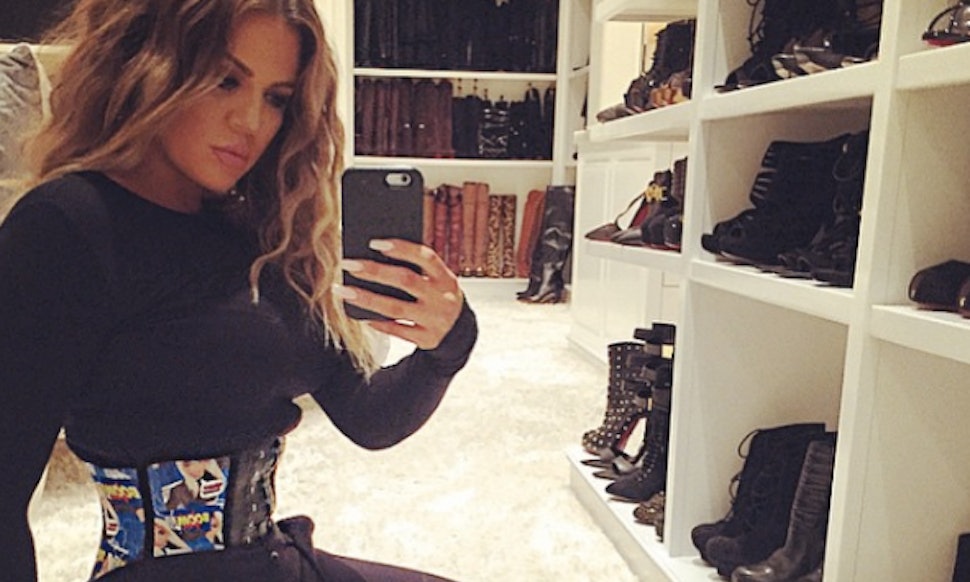
Khloe Kardashian / Instagram
Every morning, before wearing work clothes, Sarah Woodyard put on a corset. As Milliner and Mantua-Maker in Colonial Williamsburg, wearing a historically accurate corset is part of Woodyard’s work, where she spends a day educating visitors about the life of the American colonies. The corset she wore was different: on some days, she wore an 18th-century accommodation; on other people, she chose a cordless corset about 1800. Either way, the corset is an important part of her work uniform. Although Woodyard can be on cotton metal or bone for up to 18 hours, she didn’t complain: “[Wearing a corset] is like you are gently holding and hugging for a whole day,” Woodyard told me. .
The corset is one of the most misunderstood costumes in fashion history. For fashion revisionists, this is a simple goal: to remove from the once decorated body, the stiff structure of the corset, and the unforgivable grill skeleton, which looks like a medieval torture device: rough But effective.
“It’s going to be a terrible thing to wear it every day. It’s like living in a cage,” says Zoe Helen, the cultural activist and founder of the cosmic sister. She is a female collective that promotes gender equality. . “[The corset] is definitely a return for women. There is no doubt in my mind, if you have doubts, you have not worn enough time,” Hailin said.
But according to Woodyard, a person wearing a corset, most of the time, a corset all day is supportive, allowing women to perform housework without back pain. “I found that they often helped my day. And the back support really helped me without pain at the end of the day. I did the laundry and cooking in the eighteenth century. When you had to pick up a heavy bucket, or bend And when moving heavy objects [support of the corset] is really helpful, “Woodyard told me.
But is the corset not very uncomfortable or even painful, and the squeezing organs will be forgotten? “I don’t think many people realize that the 18th century manufacturers… [make women] a person who is suitable for [their customers] and is very suitable for them,” Ms. Woodyard said. . “So I often fit the tight words and should install the pillars, but they shouldn’t be tight. If they are too tight, then you need to fix them.”
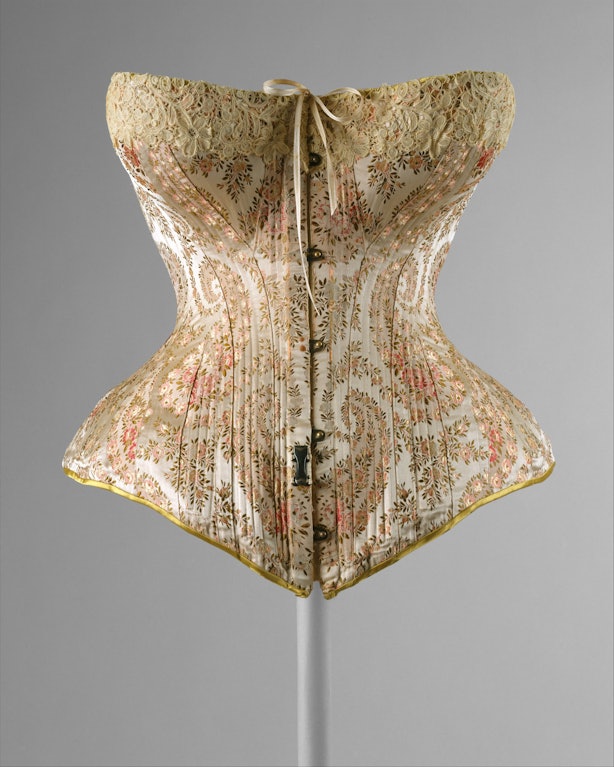
French corset, 1891, provided by the Metropolitan Museum of Art
In addition to fit, tight or somewhere in between – tights have a long history and far exceed our current assumptions. When Minos women in Crete bind their breasts with a soft leather called apodesmos, they can be extended to ancient times by using underwear to manipulate the body. However, with apodesmos, the body still plays an important role in shaping the clothes that wrap it around. It was not until the Middle Ages that the human body was considered an object that needed to be occluded or changed. As the French historian Georges Duby wrote in his book “L’Europe au Moyen Age”, the decorations and decorations associated with that era “masked the body and wrapped it in an unreality.” In the middle, it masks the characteristics of men and women.”
The origin of the word “bobs” that describes the fit of women’s underwear is vague. According to Dr. Joan Evans’s book “Fashion in Underwear: From Babylon to Bikini Briefs”, in the Middle Ages, the term ironically expressed some kind of cloak for men. Until the turn of the 19th century, “bobs” were used to describe controversial underwear (it was called “stay”). Still, the earliest corsets were not even underwear. Originally in the 13th century, it described a soft, fitted bodice that was clipped around the waist and worn on linen. This basic form is used as a blueprint for shaping the body of Western women, with different versions of corsets from centuries, from the stiff accommodations of the eighteenth century to the corsets that exist today.
“There is no natural body, only a cultural body,” Denia Bruna, the exhibition host of the Bard Research Center, wrote in an article in the exhibition catalogue: “Shaping the body”. The body is the reflection of society and presides over its creation. “In other words, underwear like a corset is used to create and shape the body, shape and disguise the body, forming a “cultural body” designed to accommodate the aesthetics of any particular time.
However, in the Age of Enlightenment, intellectuals began to question the corset and its techniques. They believed that the corset was at best a physical manifestation of the censorship system. Worst of all, it was a way of deforming and destroying the natural body. Anatomists and doctors began to recommend not to wear accommodation.
In 1768, French doctor Joseph Lalíin wrote in his declaration “De la conservation des enfants” that “these whales are harmful during pregnancy.” Naturalist Buffon wrote, “This discomfort The clothes – thought to support the waist and prevent it from losing shape – actually produce more discomfort and deformity than it prevents.”
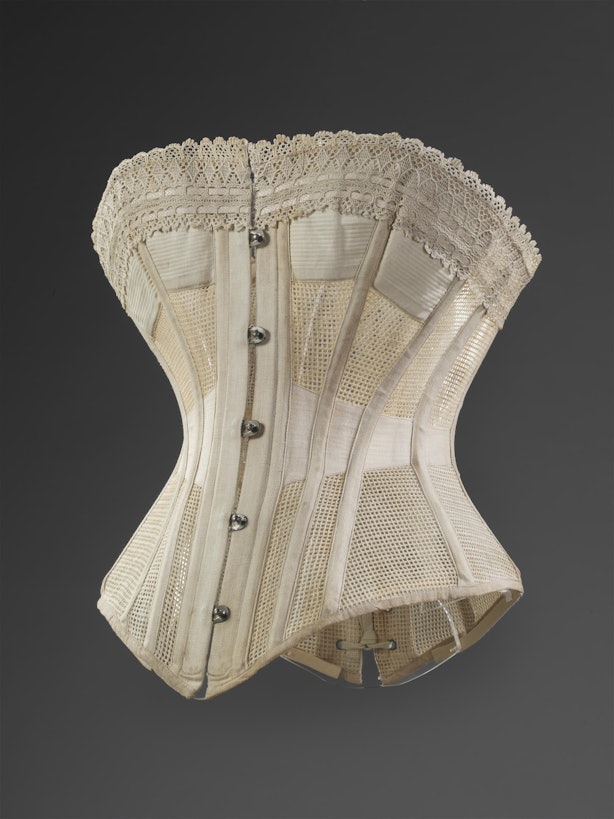
British or German corset between 1895-1900 © London Victoria and Albert Museum
But it is worth noting that these criticisms are mainly directed at women, although the body’s “abnormality” is imposed from birth. According to an article by Anaïs Biernat in Fashioning The Body, babies begin to live to encourage warmth and the development of straight spine. As they grow, both boys and girls wear a preventive orthopedic device to ensure proper spinal alignment. Once the boy is six years old, they will give up and the girl will continue to wear.
In general, women ignore these criticisms. In fact, there is ample evidence that most women (and even some women are supporters of fashion reform) still believe that wearing a corset is essential, even if men ridicule them with ironic attacks, such as articles, poems and illustrations. The ironic way of creating a man-made body like a corset and a skirt and a skirt. This has led to a loophole in the popular concept that women wear only a corset to enter the ideal shape of a male gaze.
“On the one hand, male gaze in the 18th century may encourage these women to wear in some way to maintain respect, because it is stressful,” Woodyard said. “But on the other hand, there is a theory that women often wear each other, And compete with each other. Therefore, during this time, accommodation is recognized as clothing, and then women may wear them because other women have greater social pressure.”
When people think of a corset, the image that comes to mind is usually the tights of the nineteenth century. Proverbs spread around, women are sick, and die from the effects of tight-fitting blouses; women are undergoing surgical removal of ribs. These rumors are fake. “A woman’s body is very malleable. You can reduce your body very comfortably without causing pain or discomfort,” Woodyard said. “I think many people have this misunderstanding that you are almost forced to enter a size of accommodation. I don’t think many people are aware of the 18th century who have left behind, their expertise to work with clients to measure their customers and make them Become a pair of people who are very suitable for them.”
Although the tight-fitting lacing – the female bodice is too tight to create a slim waist – although it has been popular in the short period of the Victorian era, it has not been widely practiced. But in fact, all the inspired satirical newspaper items and comics (of course men) are ironic (and exaggerated) that women will blindly follow the whims of fashion. It also helps to continue the view that corsets are somewhat “unnatural” and “oppressive”, a concept that leads to the underbody of a corset called the “belt”. An evolution.
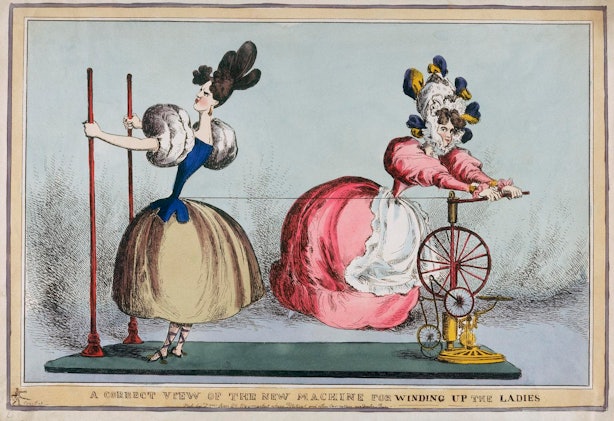
An etching by T. McLean was published in 1830 as “a fresh machine that correctly observes new women”, showing a Victorian woman wearing her corset tightly.
By the beginning of the 20th century, these negative attitudes toward corsets began to surface. This paved the way for designers like Paul Poiret and later Coco Chanel, and loudly claimed that they had killed the corset and then liberated women from oppressive clothing. But this “victory” is at best empty: women just wear a corset and change into a belt. Although not so nervous, they still shape the body to suit specific body ideals.
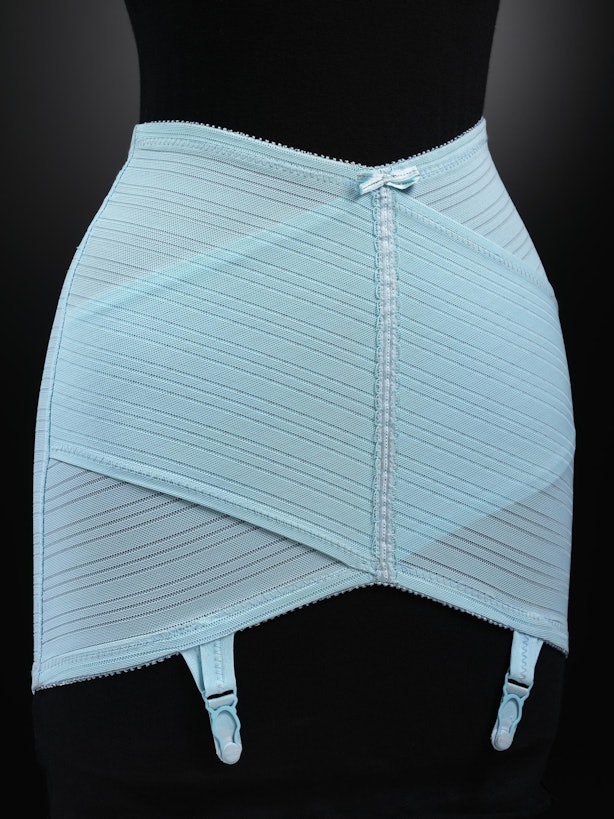
Belts of the 1960s © London Victoria and Albert Museum
For decades, the belt has been adjusted to the boyhood of the 1920s, the tortuous curves of the 1930s, the sharp lines of the 1940s and the women’s hourglass of the 1950s. However, when the second wave of feminism emerged in the late 1960s, the belt began to fall out of favor. In the 1980s, diet, exercise, and plastic surgery took over and controlled the body into a perfect form of exercise.
Until the beginning of the 21st century, with the introduction of Spanx, a new form of tights was once again widely used to create the illusion of an idealized body under clothing. Today, women continue to try to manipulate their bodies, and Kardashian and Instagram stars like to sell waist trainers – a corset-like device that promises to reduce the waist to get the perfect hourglass shape.
When the extreme version of the garment dominates our understanding of the corset, it is easy to fall in love with the corset, which is the subsequent evolution. When our understanding of historical dress is rooted in books or museum exhibits, they are removed from the person wearing them, and the bodice looks like an abstract torture device. However, like all clothes, it is a living, so it is not a consistent static image; instead, it is a clothing suitable for the wearer – choose the person who wears it.